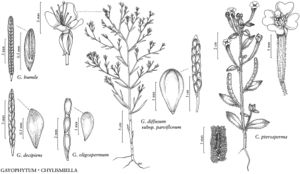Gayophytum decipiens
Brittonia 16: 368, figs. 5H, 6C. 1964.
Herbs glabrous or villous to strigillose. Stems erect or proximalmost branches decumbent, branched throughout, usually with 2–8 nodes between branches, branching usually not dichotomous, 5–50 cm. Leaves somewhat reduced distally, 10–32 × 1–4 mm; petiole 0–5 mm; blade narrowly lanceolate to sublinear. Inflorescences with flowers arising as proximally as first 1–5 nodes from base. Flowers: sepals 0.7–1.1 mm, reflexed singly; petals 1.1–1.8 mm; pollen 90–100% fertile; stigma subglobose, surrounded by anthers at anthesis. Capsules usually ascending, rarely reflexed, not conspicuously flattened, 6–15 × 0.6–1 mm, with inconspicuous constrictions between seeds, valve margins slightly undulate, all valves free from septum after dehiscence, septum straight; pedicel 0–5 mm. Seeds 10–25, all developing, arranged ± parallel to septum and subopposite seeds in adjacent locule, forming 2 even rows in capsule, light-brown, sometimes mottled with dark-brown, 0.8–1.8 × 0.3–0.7 mm, glabrous or densely puberulent. 2n = 14.
Phenology: Flowering May–Sep.
Habitat: Sandy or gravely soil, in pinyon-juniper woodlands and pine forests, desert ranges, mountains bordering desert areas.
Elevation: 1800–4200 m.
Distribution
Ariz., Calif., Colo., Idaho, Mont., Nev., M.Mex, Oreg., Utah, Wash., Wyo.
Discussion
Gayophytum decipiens may be one of the parents of the allotetraploid species G. racemosum. Since some collections of the tetraploid G. diffusum subsp. parviflorum closely resemble G. decipiens, the latter has probably contributed to the extensive variation in the G. diffusum polyploid complex. Among the diploid species, G. decipiens is most similar to G. ramosissimum but can be distinguished by its branching habit and capsules.
Selected References
None.
